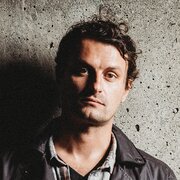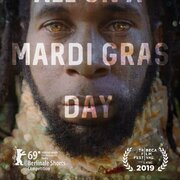Interviewed & Written by Sana Rizvi
So here is the thing about a short film - so much beauty, reflection and impact is packed into less than 30 minutes, that one walks out of the cinema feeling way more knowledgeable about the world we live in than what we probably did before. Michal Pietrzyk's directorial debut All on a Mardi Gras Day does this and much more. The film is a revelation.
Continuing the dialogue that we are having through this year's Film Programme on preservation of music, cultures and traditions, All on a Mardi Gras Day is an intimate portrait of one man's obsessive journey through the secret 200-year culture known as Mardi Gras Indians: African-American men who spend all year making feathered suits to honour their runaway slave ancestors and the Native American tribes who housed them during their escape.
Behind the drawn shades of a run-down home on the outskirts of New Orleans, Demond Melancon is creating a masterpiece. When it's done, it'll weigh 100 pounds, contain nearly 1 million individually sewn beads, and make him 10 feet tall. He'll wear it one time, then start the whole process again.
Everything builds to Mardi Gras Day when hundreds of Indians from all over the city present their year's work and confront one another in peacocking battles to decide who's "the prettiest." But in a city struggling from poverty, drugs, and violence, just finishing your suit, let alone making it to Mardi Gras, aren't guaranteed. And when something goes wrong on the big day, Demond's year-long efforts may be in jeopardy.
WOMEX Film's Sana Rizvi, had the opportunity to speak to director Michal Pietrzyk on his first indie documentary, the incredible access he got into a culture normally off-limits to non-Indians and all the oysters he ate in New Orleans while making the film!
How did you get access to this secret hidden world of Mardi Gras Indians?
Michal Pietrzyk: Through one of our producers, David Favret, who became friends with Big Chief Demond a few years ago. Without the personal relationship he had with Big Chief Demond, we wouldn't have been allowed into this incredible world.
What facets of Mardi Gras history intrigued you during your research, did you had the chance to find out more about the Native American and African American encounters in the 18th and 19th century and what role are the Mardi Gras celebrations playing nowadays?
Michal Pietrzyk: The goal of the film was never to tell the history of the Mardi Gras Indian tradition, but to tell a personal story about one individual, the obsession he has with the culture, and the collateral damage it has on his life. My research was on Big Chief Demond and his life, his past, his emotions. I was learning about the Mardi Gras Indian tradition from him during the course of filming. In the film, he talks about the "stories" that were told to him – this is an oral tradition that is passed down from one generation of Mardi Gras Indians to the next. It was never my intention to fact-check anything he said; I was only interested in his version of the story.
What kind of story were you trying to tell with the film?
Michal Pietrzyk: I was less interested in exposition about the Indians; I'm not sure it's my place, as a white guy who's not even from New Orleans, to tell that story. I wanted to focus on one person and their obsessive journey to complete their suit. Why do they do this? What sacrifices do they make? What is the collateral damage to their lives, and those around them? While it took our co-producer David years to get access to the culture, I met Big Chief Demond the day before the first of 8 total shooting days: a necessary evil for this self-funded passion project. With a less charismatic character, the lack of prep or rapport-building would've hurt the film, but from our first meeting, I saw that Demond's passion for the culture, its meaning, and what it did for his life, was so strong that the story was already bursting out of him.
The cinematography is absolutely stunning! Could you take us through a day of shooting with Demond and the clan?
Michal Pietrzyk: All credit for the cinematography goes to our DP, Gabriel Bienczycki. We knew we were going to have a tiny crew (it was just the two of us), and Gabe made the correct decision to have the smallest possible footprint during filming. He used only practical lighting and shot the whole film on a DSLR camera. It allowed us to be very intimate with Big Chief Demond, to be close in tight spaces, both in the sewing room and on the street during Mardi Gras. Also, Gabe is a trained dancer and has an incredible awareness of movement. Those two elements are really what make the film.
You started your career in unscripted TV –did that help you in the kind of storytelling you have achieved in All on a Mardi Gras Day?
Michal Pietrzyk: Definitely, because it helped me realise what I didn't want this film to be. Unscripted TV is a lot of things, but "subtle" is not one of them, and I realised to make the film work, it had to be subtle; it had to be unlike the projects I had worked on previously. But I didn't realise that until I was in the editing room. My first assemble edit of the film was terrible; it was too expositional, it gave away too much information too early. That's something you have to do when your audience can change the channel with a flick of a button, but when they're going to a theatre to see a film, they're committed, and you give them the information, the story, in more incremental pieces. It's the difference between an active and a passive viewer, and my background in TV definitely helped me recognise that.
You've mentioned that the making of the film was a transformative experience. Could you elaborate a bit on that for us?
Michal Pietrzyk: The irony of strong black men sewing feathered suits, beating their chests and confronting one another with shouts of "I'm the prettiest!" Making All on a Mardi Gras Day was definitely a transformative experience. I was repeatedly surprised by Demond's sensitivity and vulnerability and realised I needed to check my prejudice - that I too have been conditioned to fear the stereotype of strong, aggressive black men. We hope our film sparks conversation, offers a unique lens on the black experience in America and contributes in some small way to helping us understand one another in these divisive times.
What is next on your plate, and what music are you listening to right now?
Michal Pietrzyk : I'm a new father, so I'd like to tell a coming-of-age story in documentary form, and would like to set it in New Orleans – there are so many characters and stories there, and I just find myself drawn to that place for storytelling for so many reasons. I'm also continuing to produce stories for documentary television, and am working on a feature film script. As for music, I'm a kid from the '90s, and find myself listening to the music I grew up on Faith No More, Soundgarden, Rage Against the Machine. I'm also having a lot of fun exposing my 15-month old daughter to the classics: The Beatles, Iggy Pop, etc. I ran a lot of "tests" to see what music she responds to, and her favourite artist, hands down, is James Brown. Experiencing music with her has been really fun.
What do you hope the audience at WOMEX will take away from the film?
Michal Pietrzyk: It sounds cliché, but I don't want to impose any conclusions on the audience. I hope it leaves them with more questions than answers. If the film sparks a good conversation or encourages someone to be more curious about our world and the people that are in it, that will be enough.
You can catch All on a Mardi Gras Day on Friday, October 25 at 18:30 at Arthouse Cinema Niagara. The film will be followed by I Snuck Off the Slave Ship directed by Cyrus Moussavi and Lonnie Holley. Moussavi, also the founder of Raw Music International and co-owner of Mississippi Records, will be present at WOMEX. And don't forget that right after we have the Meet the Filmmakers reception from 19:30-20:30 at the cinema's cafe. See you then.
article posted by:Sana Rizvi, Piranha Arts




